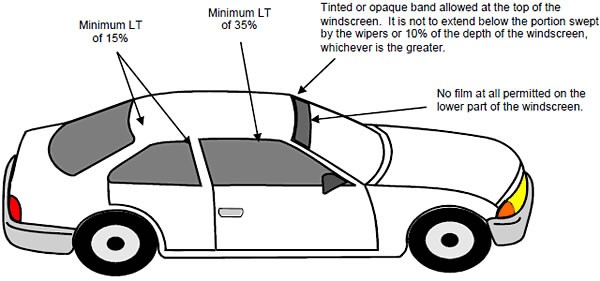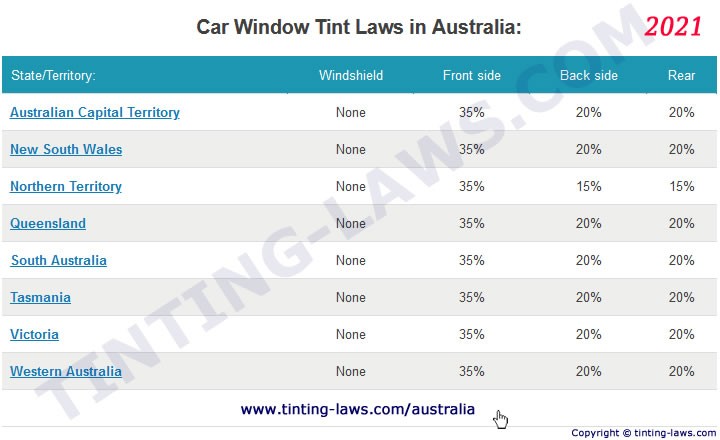Australia window tint laws are different in certain territories and states.
This article provides all relevant information about window tinting laws in Northern Territory (NT).
Northern Territory Window Tint Laws
- Windshield: Only uppermost 10% of windshield may be tinted.
- Front side windows: Must have more than 35% VLT.
- Back side windows: Must have more than 15% VLT.
- Rear window: Must have more than 15% VLT.
In Northern Territory (NT) windshields may only have a tinted strip on top, equaling to either 10% of total windshield area, or the portion of the windshield above the reach of windshield wipers, whichever is greater.
Front side windows must have a minimum of 35% light transmittance, or block 65% of total light.
All windows behind driver (rear side windows, rear window) may have 15% light transmission or more.

Tinting windows below 70% VLT requires having left and right external rear view mirrors.
Other NT tint laws:
- Reflective or mirror-like tinted film is not permitted above 10% reflectance value.
- Front windscreen may have 70% VLT in case vehicle was manufactured before 1971.
- Interior car windows must have over 70% light transmission.
- Any coating or tint applied to vehicle windows and windscreens must be non reflective (i.e. reflectance must not exceed 10%) and must be uniform (i.e. no distortion or bubbling).
- Certain heavy vehicles, buses and goods-carrying vehicles may have any window tint percentage behind driver; see Australian Vehicle Design Codes to see if your vehicle qualifies.
NT tint law sources
Northern Territory Government, Vehicle Standards for Registration, Window Tinting Standards. Windscreen tinting in Appendix F – Windscreen damage and repairs.
NT Government Information Bulletins: see V51 – Vehicle window tinting (.PDF file).
These Northern Territory tinting laws are effective since 21 December, 2015.
Car window tint laws in Australia
Each AU state or territory has its own rules and regulations, and violating vehicle equipment laws may get you in trouble when visiting other parts of the country.
See our main Australia Window Tint Laws page for an overview of car tinting laws for all territories and states and to find out if Australian Capital Territory Window Tint Laws are legal in other parts of Australia.

More AU tint laws info
- AU Vehicle Design Codes – see AU vehicle classification to learn if you can tint below limits.
- Jurisdictions – learn which state or territory laws apply to you.
- Penalties – fines and other penalties for violating vehicle equipment laws in Australia.
- Factory Tint – some car windows are already tinted, find out if yours are.
Relevant information
To learn more about window tint and laws be sure to check some of our articles!
- Tint Darkness Percent Examples – find out how VLT works and how various levels of light transmission look.